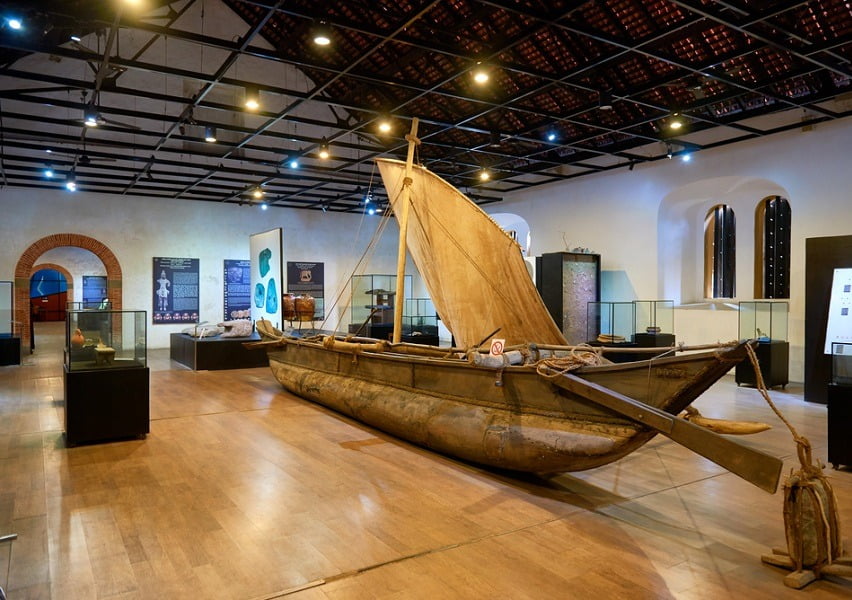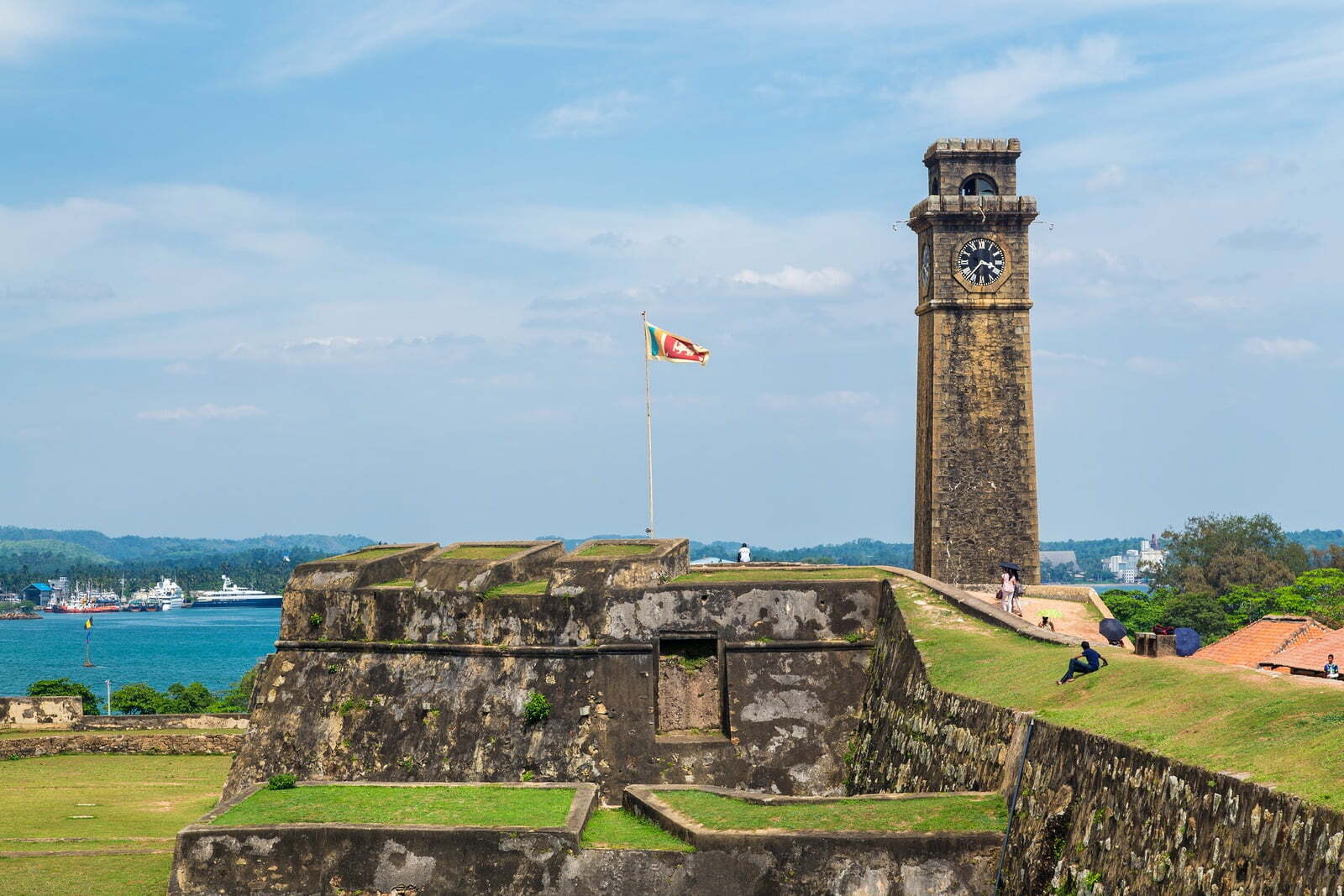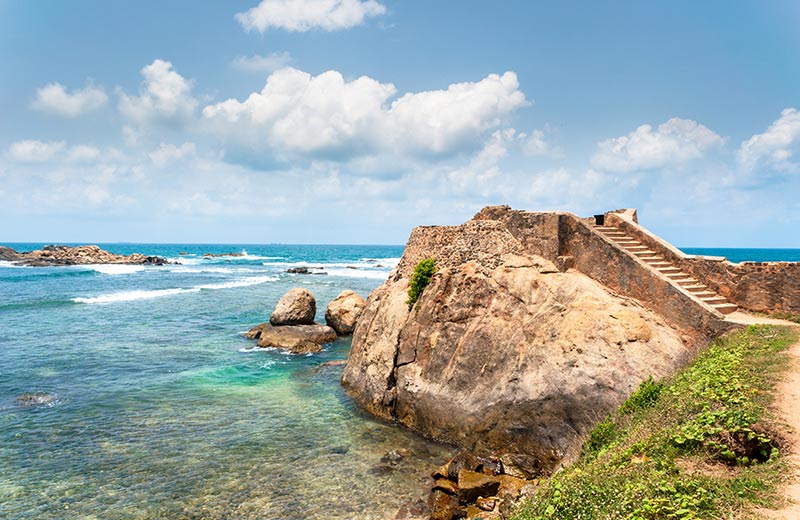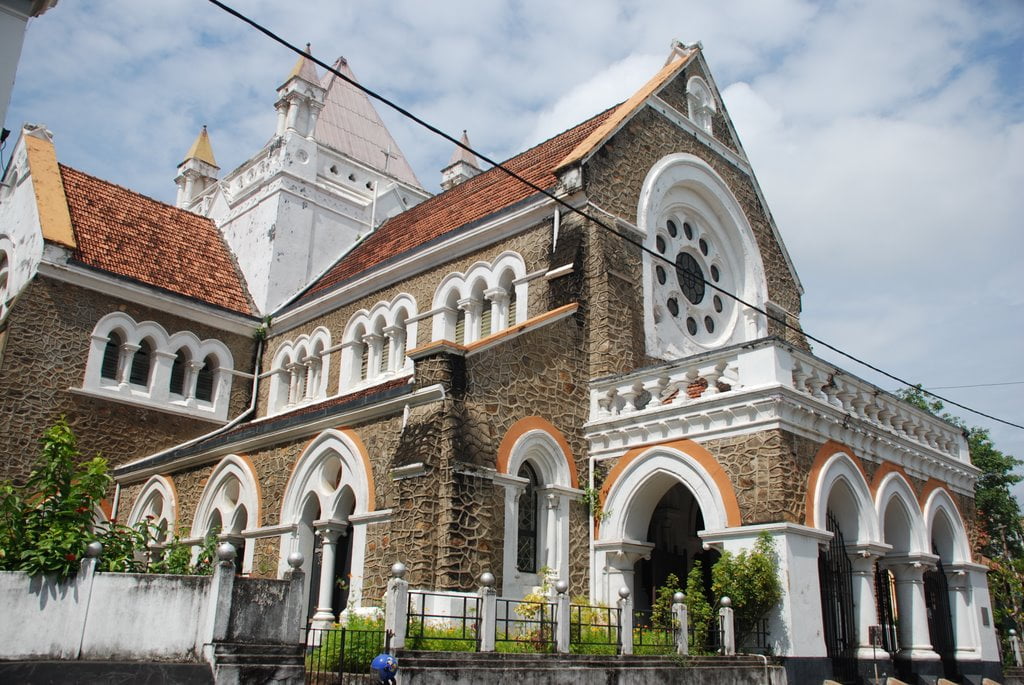National Maritime Archaeology Museum
The Old Dutch warehouse built into the Galle fort ramparts in 1671 later housed the original Dutch Maritime Museum, which was completely destroyed by the 2004 tsunami, together with its unique exhibits and valuable artifacts.
In 2010 it was reopened to the public, as the fully refurbished National Maritime Archeology Museum covering 40,000 sq. ft. space, funded by the Netherlands government, and is a treasure trove of marine biological and anthropological artifacts of the Southern coastal area.
This two-story structure has dual access with its upper-level entry opening to the current main gate while the lower level access wears its imposing VOC: Dutch East India Company insignia, operating as the main gateway accessible to vehicular and pedestrian traffic.

The first level showcases modes of vessels used in passenger transport and maritime trading in Southern Sri Lanka. Also on show are exhibits, replicas and models depicting traditional lifestyle of coastal fisher communities in the down south and their traditional fishing techniques and fishing gear.
The second level concentrates on marine ecosystems, marine flora and fauna in addition to taxonomic details of seashore plants, models of mangroves, turtles, marine mammals and sea birds. There are also specimens of corals, invertebrates and marine shells on exhibition. Besides, there is a huge skeleton of a Whale mounted on the ceiling offering the viewer an authentic feeling of awe.
This Maritime Museum is a rich source of knowledge for researchers and groups of scholars, on the lives in the down south coastal areas connected with, dependent on and living within, the Ocean.
The Museum opens from 9 am to 5 pm except on Sundays, Mondays and Public Holidays. It’s absolutely worth your visit when you walk around Galle Fort, and you would be richer by the new experience!

Galle Fort Clock Tower
Located a 3.5 kilometres from Galle City centre this popular landmark rises a good four stories high at 25.3metres (83ft.). Built by the British in 1883, it is immediately within the Fort ramparts overlooks the central Moon Bastion on one side and the International Cricket Stadium on the other.
The funds for its construction were raised through public subscription as a mark of respect for colonial surgeon Dr. P.D. Anthonisz, a member of the first Legislative Council of Ceylon, born in Galle. The inscription on the clock tower notes that the clock was a gift from a grateful patient Mudaliyar Samson De Abrew Rajapakse. The statues built around the clock tower were erected after Sri Lanka attained independence.
Galle Fort – Flag Rock Bastion
To warn ships of the danger of underwater rocks, the Dutch used wave flags and when visibility was low, they fired muskets from Pigeon Island. Today, Flag Rock Bastion on the southern edge of the Fort is a popular happening spot drawing crowds to watch diving stunts and the sunset from the row of cafes running along Rampart Street seawall.
Galle Fort Ambalama
The ambalama has been the heaven-sent restroom at a time in history when common transportation was by foot. At the far end of the Galle Fort in Courthouse Square, you find this simple, popular wayside brick and mortar elevated resting platform with an overhead roof supported by four cylindrical pillars. This elevated ambalama with no side walls, is unique from any other found elsewhere. It underwent restoration in 2008 and is still in use as a point of rest to break the journey.


All Saints Church
This Anglican Gothic Church with beautifully intricate stained glass windows and grand arches beckon devotees from early morning as the church bells chime. Dating back to 1871 this strong structure holds its own, resilient against the centuries of weather, winds and time.
Kloppenburg Bastion
In the time past, to ward off any contenders out at sea, the Dutch built Galle Ramparts doubly strengthening them with four bastions and Kloppenburg Bastion is one. Dating back to times when gunpowder and cannon balls could break through any strong wall or barricade, the bastions served as gun platforms specifically designed to deliver focused long-range firing at any attacking ships at sea.
What attracts are there in close proximity
Closer to Galle, you will discover splendid beaches, turtle hatcheries, trekking grounds, legendary hills that rise from the sea, lush rainforests urging you on a memorable wildlife safari, Ceylon Cinnamon plantations and White-tea estates inviting you on a sightseeing tour, winding up with tea and love cake. A mountain of attractions make Galle an extraordinary must-visit site on your itinerary.
Whale and Dolphin Watching: It all happens right here!
If the wilds and the ocean are two of your favourite holiday dreams, come to Sri Lanka! It’s the amazing ‘Diversity Destination’ having it all and more! Petite it may be in size but the island’s treasures come in gigantic sizes. From the largest Asian Elephant – the Sri Lankan Tusker to the planet’s biggest Blue Whale, live and thrive within our shores. It’s a treasure island packed with wonders worth experiencing!
Have Whale and Dolphin Watching right on top of must-do things when you arrive in Sri Lanka because you are lucky it’s the best happening season from April to July in Trincomalee, this peak time of the year! It’s the season, where your chances are at an extreme to catch the beautifully awe-inspiring sight! Have your eyes scanning the blue waters when on your Whale Watching tour, as you are bound to discover the Blue Whale and Sperm Whale rising off the blues magically within 30 minutes of boat drive and below ten nautical miles off shore. You will be delighted with Spinner Dolphins doing their drill to thrill you in their tens and twenties!

There is another alternative way to get a glimpse of a Whale from Swami Rock, an overhanging craggy high vantage point in Trincomalee, if boat rides are not your comfort zone.
It is relevant to be concerned about our responsibility towards protecting our environs and every living thing in our ecosystem and ensuring the safety and survival of us all. It is of great importance to maintain a safe distance and not overcrowd the boats on your tour to watch the majestic spectacle to safeguard all.
The ocean is sacred to us all, so bringing back any disposable garbage with you is crucial without littering the life-giving waters. Make unforgettable memories of your journey and take away videos and photos of the magnificent gentle giants of the ocean and entertaining Spinner Dolphins in the emerald waters of resplendent Sri Lanka!

Make an unforgettable visit to a turtle hatchery
Babies have a way with our hearts! They will steal yours when you stop over at the Kosgoda Hatcheries where you are bound to find them in all their loving shades of Leatherbacks, Hawksbills, Loggerheads, Green Turtles and the Olive Ridleys, the five species of turtles in the island. Kosgoda, located down south, is one beach in the island where all five species tend to make their nests.
This place is a dedicated turtle welfare centre which nurtures and cares for them from the onset until the little ones hatch and take to their home, the ocean.
Their task begins long before the babies are born. They watch over the nestling mother and once the eggs are laid these are transferred to the safe grounds of the hatchery. The day the babies are born, they are safely released to the waters. If any complications occur, they are tended to and released only when these babies are fit to begin their life journey in the vast ocean.
Sea turtles have become an endangered species all because natural resources are being exploited by human beings. This hatchery has passionately taken up the responsibility in protecting these harmless creatures who are a gentle part of our universal ecosystem supporting the survival of man and the planet.
It would touch your hearts once you drop in to see these lovable little ones at Kosgoda Hatcheries. You may even get the opportunity to release the babies to the ocean if you speak to the staff in there. It would surely fill your heart with emotion, remembering how the delicate babies you released off your hands, ran to the great ocean flapping with joy, like a child would, to their mother.


